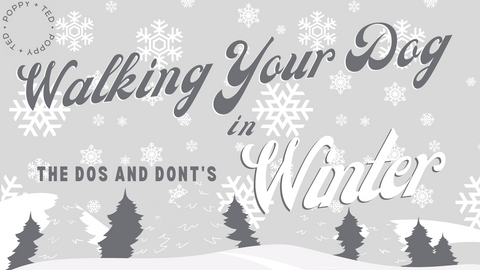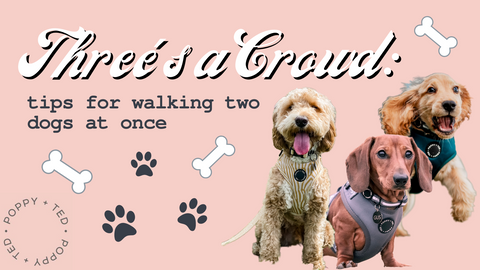 When it comes time for walkies, most dogs can not contain their excitement. Their tails begin to wag at record speed, and some use their voices to let you know they’re ready to go.
When it comes time for walkies, most dogs can not contain their excitement. Their tails begin to wag at record speed, and some use their voices to let you know they’re ready to go.
But if your dog shows signs of stress when they see their collar, or you struggle to put it on them, walkies can suddenly become challenging. Of course, you can’t just trust your dog to walk alongside you with no collar or lead- both for their safety and to comply with orders requiring dogs to be on leads in various public areas.
So, what can you do to encourage your dog to wear a collar? We are here to help at Poppy & Ted.
Why Won’t My Dog Wear Their Collar?
If your dog is resisting wearing a collar, don’t think too badly of them. After all, it’s like getting a baby to wear shoes or keep on a hat. It feels unnatural to them until they get used to it.
Some dogs may find wearing a collar restrictive or uncomfortable, and they might not understand why they need to wear one. Especially if you only put a collar on your dog to take them on a walk, it might become harder to persuade them to wear it.
It will be apparent if your dog does not like their collar as they will bite and scratch at it and turn in circles as they walk when it's on. This is all down to basic instincts, as no dog is born wearing a collar. It will just take a bit of extra tender love and care to get your dog used to wearing a collar, and we can help you with that!
How to Make your Dog Comfortable Wearing a Collar
Luckily, like any tricks and behaviours, you want your dog to learn, it can be achieved with patience, training and love. So, if your dog resists wearing his collar, all is not lost. To help you encourage your dog to wear its collar, here are four simple steps you can follow. Remember that patience is key, and your dog takes their emotional cues for you!
1. Choose the Right Design and Fit
First, ensure your dog’s collar is comfortable and fits well. Too tight will put pressure on your dog’s neck and cause strain as they try to walk, which is why they may struggle wearing it. Conversely, if the collar is too loose and sits too far down the neck, this will irritate and increase the risk of your dog coming off the lead as you walk.
We recommend choosing an adjustable, flat buckle collar for your dog to ensure optimal comfort and safety. At Poppy & Ted, we have a collection of adjustable collars available in a range of sizes to get the most accurate fit for your dog, no matter their breed or size.
With an adjustable collar, you can ensure the collar fits as it should using the finger test. Start by choosing a dog collar that fits the size measurements of your pooch, and then adjust it to be tight but not snug. For small dogs, you should be able to slip one finger under the collar; for average-sized dogs, it is two fingers. With larger dogs, you should be able to fit three fingers under the collar.
2. Train with the Collar
Once you have the right fitting collar, it’s time to put it on while causing minimal distress for your dog. For many, this can be the hardest part.
There are several ways you can make putting on a collar calmer and less stressful for your dog. Start by avoiding combative behaviours, making the process much less daunting for your dog. This means you shouldn’t chase your dog to put on its collar or restrain it. Remember to remain calm and relaxed, as your dogs are intelligent creatures that can sense your frustration and react to it.
Train your dog to get used to its collar through positive reinforcement that will prepare your dog for wearing its collar for longer periods. Simply sit on the floor with the collar and reward your dog with a treat every time they sniff or touch the collar. Once they seem comfortable with this stage, move on to holding the collar loop above your dog’s head, but do not rush to put it on. Again, reward your dog with a treat every time they touch the collar with their nose or put their head towards the loop.
Gradually work your way to putting the collar on fully, rewarding your dog at every step. Slowly, they will feel more comfortable and associate wearing their collar with treats and rewards.
3. Attach the Lead
Now your dog is wearing their collar, you may be wary of disturbing them and breaking the calm spell. But if you want to take them outside, of course, you need to attach the lead.
Make sure your lead has an easy trigger hook fastening that is quick and simple to attach to your dog’s collar while also being secure and durable. Our selection of standard dog leads come equipped with these fastenings as standard and are as comfortable to wear and use for humans as they are for dogs.
To attach it, simply distract your dog while you put two and two together, either with a treat or their favourite toy.
4. Train Collar Pressure
Wearing the collar is step one, but attaching it to a lead can be another problem. It is important to continue training your dog through collar pressure, so don’t put those treats away just yet.
Regarding collar pressure, your dog may have a minor freak out at the sensation, which causes them to buck, hop and even pancake on the ground. When this happens, you should immediately stop walking, do not tug and pull your dog.
Remember to let your dog control the pressure by walking closely with them. Let them pull against the collar and lead while you hold it steady. Once your dog stops pulling on the lead, reward them with a treat. By doing this, you’re teaching your dog to move with pressure.
Is a Harness Better than a Collar?
What happens when you have followed our advice, but your dog still struggles to wear a collar?
In that case, it might be time to try a harness for your dog. Similarly, swapping your dog’s harness for a collar may make walkies much smoother if you have the reverse problem. This is because there is no clear winner in the debate of collars vs harnesses, and each has positives and negatives that you may value differently for your dog.
We have a huge selection of safe and comfortable adjustable harnesses on offer. In our guide, you can learn more about the pros and cons of harnesses vs collars.
Get your Dog Comfortable in their Collar
We hope you have found the advice and guidance you need here to get your dog comfortable wearing their collar. Once you have mastered the training and got your dog feeling calm in a collar, you can look forward to plenty of fun and relaxing walks together.
Remember, you can shop our collection of strong and comfortable adjustable collars at Poppy & Ted, as well as a range of matching harnesses and leads.
Find the perfect size using our handy online dog size guide!
Related
Harness Vs Collar: Which Is Better For Your Dog?
Help Your Dog to Love Their Harness



